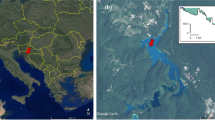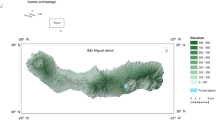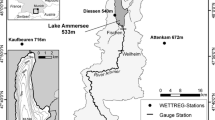Abstract
To prevent the recurrence of a disastrous eruption of carbon dioxide (CO2) from Lake Nyos, a degassing plan has been set up for the lake. Since there are concerns that the degassing of the lake may reduce the stability of the density stratification, there is an urgent need for a simulation tool to predict the evolution of the lake stratification in different scenarios. This paper describes the development of a numerical model to predict the CO2 and dissolved solids concentrations, and the temperature structure as well as the stability of the water column of Lake Nyos. The model is tested with profiles of CO2 concentrations and temperature taken in the years 1986 to 1996. It reproduces well the general mixing patterns observed in the lake. However, the intensity of the mixing tends to be overestimated in the epilimnion and underestimated in the monimolimnion. The overestimation of the mixing depth in the epilimnion is caused either by the parameterization of the k-epsilon model, or by the uncertainty in the calculation of the surface heat fluxes. The simulated mixing depth is highly sensitive to the surface heat fluxes, and errors in the mixing depth propagate from one year to the following. A precise simulation of the mixolimnion deepening therefore requires high accuracy in the meteorological forcing and the parameterization of the heat fluxes. Neither the meteorological data nor the formulae for the calculation of the heat fluxes are available with the necessary precision. Consequently, it will be indispensable to consider different forcing scenarios in the safety analysis in order to obtain robust boundary conditions for safe degassing. The input of temperature and CO2 to the lake bottom can be adequately simulated for the years 1986 to 1996 with a constant sublacustrine source of 18 l s−1 with a CO2 concentration of 0.395 mol l−1 and a temperature of 26 °C. The results of this study indicate that the model needs to be calibrated with more detailed field data before using it for its final purpose: the prediction of the stability and the safety of Lake Nyos during the degassing process.
Similar content being viewed by others
Acknowledgments.
The authors would like to thank M. Kusakabe (Okayama University, Japan) for providing CO2 and temperature profiles, J. Hell (IRGM, Cameroon) for providing the infrastructure at Lake Nyos, C. Dinkel (EAWAG) for taking over a large part of the field work at Lake Nyos, P. Reichert and B. Wehrli (EAWAG) for support in the model development and M. Kusakabe and an unknown reviewer for their detailed and constructive reviews of the original manuscript.
Author information
Authors and Affiliations
Corresponding author
Additional information
Responsible Editor: Hans Burchard
Rights and permissions
About this article
Cite this article
Schmid, M., Lorke, A., Wüest, A. et al. Development and sensitivity analysis of a model for assessing stratification and safety of Lake Nyos during artificial degassing. Ocean Dynamics 53, 288–301 (2003). https://doi.org/10.1007/s10236-003-0032-0
Received:
Accepted:
Issue Date:
DOI: https://doi.org/10.1007/s10236-003-0032-0




